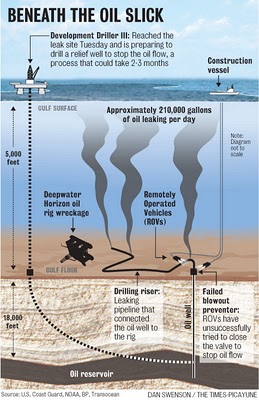The ongoing environmental disaster in the Gulf of Mexico has much of the anti-environmentalist bloggersphere ducking its collective head beneath the parapet. Suddenly, America is aware that offshore oil drilling has the potential to wipe out the livelihoods of entire coastal communities. Perhaps, now, proposals to drill for oil in the Arctic will be examined more closely, and the views of indigenous populations considered more adequately. If disaster mitigation in the Gulf is difficult, imagine how much more difficult it would be in Arctic waters.
Latest news and updates
An official web site has been established to provide frequently updated information about the Gulf of Mexico Deepwater Horizon incident:
http://www.deepwaterhorizonresponse.com/go/site/2931/
The United States Coast Guard web site also has frequently updated information:
http://www.uscg.mil/
I have remarked before about my dislike of web sites which make use of the term 'truth'. However, for frequently updated satellite images and a relatively hype-free analysis I can gladly recommend:
http://blog.skytruth.org
A tiny nonprofit group with one paid staffer in a one-room office in a small West Virginia town has been causing U.S. officials and oil company executives to backtrack and revise their estimates of the size and flow of the oil spill in the Gulf of Mexico.
http://articles.latimes.com/2010/may/01/nation/la-na-oil-spill-measure-2...
How bad might it get?
The rate at which any fluid under pressure can escape through an opening is determined by the viscosity, by the difference between the fluid pressure and the back pressure, and by the cross-section area of the orifice. At the time of writing, oil is coming from a pipe 18¾in internal diameter with a possibly partly closed valve. The pipe is specified to handle 15,000 psi. As the unchecked and rapid flow effectively grit-blasts the valve and pipe, the time will come when the oil flows from the full 18¾in bore, checked only by the back-pressure of 5,000 feet of sea water.
The DEEPWATER HORIZON is a Reading&Bates Falcon RBS8D design semi-submersible drilling unit capable of operating in harsh environments and water depths up to 8,000 ft (upgradeable to 10,000 ft) using 18¾in 15,000 psi BOP and 21in OD marine riser.
http://www.deepwater.com/fw/main/Deepwater-Horizon-56C17.html

When oil lines fail to fail safe
When safety depends on the ability to shut down a system by blocking a fluid flow it is absolutely imperative that the system should incorporate 'fail safe' design principles: the system should fail into the safest possible state. In general, that means that an oil or gas line should never rely on a single 'stopcock' and should never, ever, depend on human intervention as a first resort in an emergency.
The U.K.'s Buncefield refinery fire was triggered when the flow into a storage tank was not stopped automatically before overflow commenced. The subsequent explosion measured 2.4 on the Richter scale.
http://en.wikipedia.org/wiki/2005_Hertfordshire_Oil_Storage_Terminal_fire
In October 2009 failure to close a master valve led to an explosion in Jaipur, India which measured 2.3 on the Richter scale. Twelve people were killed and over 200 injured by the explosion and the subsequent uncontrollable fire.
http://oisd.nic.in/
The Piper Alpha oil rig disaster was not caused by a failure to close a valve, but by a failure to lock down an out-of-service pump to prevent its being started up in error. Over and again it has been shown in industry that paperwork is not sufficient to prevent accidents. As a minimum requirement, any plant under maintenance which is capable of causing death or injury if put into operation must be physically locked down, and keys rigorously accounted for.
http://en.wikipedia.org/wiki/Piper_Alpha
Oil rig and refinery operation can never be entirely safe. But must we keep repeating a history of similar events?
Environmental impacts
The impacts on livelihoods and wildlife around the Gulf are obvious and immediate. Less obvious is the potential for more widespread impacts.
The waters of the Gulf of Mexico flow out into the Atlantic where they combine with other flows and form the Gulf Stream. If the oil cannot be contained it is possible that parts of the Atlantic coast of Florida will also be contaminated.
... the oil spill has now spread out and is located just NW of the Loop Current in the Gulf of Mexico. The Loop Current is part of a network of currents that run through the western Caribbean, the Gulf of Mexico and the Atlantic Ocean. The Yucatan Current runs northward into the Gulf of Mexico where it wraps around in the in the Loop Current. From there it exits the Gulf very near south Florida in the Florida Current. It eventually wraps it's way up the east coast in the Atlantic Ocean as part of the Gulf Stream current. The Loop Current gets it's name from the shape it takes. The current moves quickly and can range anywhere from 1-2 m/s or 3-6 ft per second.
http://www.wtsp.com/news/local/story.aspx?storyid=131136&catid=8





Comments